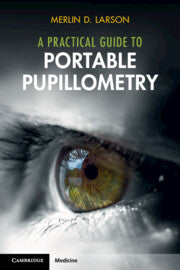A Practical Guide to Portable Pupillometry
- Unit price
- / per
-
Author:LARSON Merlin
-
ISBN:9781009436298
-
Publication Date:November 2024
-
Edition:1
-
Pages:166
-
Binding:Paperback
-
Publisher:Cambridge University Press
-
Country of Publication:United Kingdom


A Back Order button means that we don’t have the book in stock at our store. It may already be on order – or we can order it for you from a publisher or distributor at no additional cost.
As we source items from around the globe, a back-order can take anywhere from 5 days to several weeks to arrive, depending on the title.
To check how long this might take, you’re welcome to contact us and we can provide an ETA or any other information you need. We recommend checking the timeframe before committing to an online order.
A Practical Guide to Portable Pupillometry
- Unit price
- / per
-
Author:LARSON Merlin
-
ISBN:9781009436298
-
Publication Date:November 2024
-
Edition:1
-
Pages:166
-
Binding:Paperback
-
Publisher:Cambridge University Press
-
Country of Publication:United Kingdom
Description
The applications and advantages of portable pupillometry for a wide variety of healthcare providers are becoming increasingly evident, with frequent pupil evaluation becoming the protocol throughout critical care and emergency departments.
Authored by a world leading expert, this practical, user-friendly book brings together all the research on portable pupillometry and explains the meaning of the various parameters that new portable pupillometers provide.
Starting with the anatomy and physiology of the pupil, the book moves on to discuss pharmacological effects, unusual pupillary syndromes, measurement and size of the pupil, pupillary reflex dilation and pupillary unrest. Additional chapters focus on traumatic brain injury, cardiac arrest, intensive care, opioid effect, acute pain and anisocoria and provide valuable clinical examples and case reports. Also featuring an extensive bibliography for further reading, this book is essential reading for all healthcare professionals using the pupil to evaluate drug effects and ischemic/traumatic insults to the brain.
Adding product to your cart
You may also like
A Back Order button means that we don’t have the book in stock at our store. It may already be on order – or we can order it for you from a publisher or distributor at no additional cost.
As we source items from around the globe, a back-order can take anywhere from 5 days to several weeks to arrive, depending on the title.
To check how long this might take, you’re welcome to contact us and we can provide an ETA or any other information you need. We recommend checking the timeframe before committing to an online order.
You may also like
You may also like
-
The applications and advantages of portable pupillometry for a wide variety of healthcare providers are becoming increasingly evident, with frequent pupil evaluation becoming the protocol throughout critical care and emergency departments.
Authored by a world leading expert, this practical, user-friendly book brings together all the research on portable pupillometry and explains the meaning of the various parameters that new portable pupillometers provide.
Starting with the anatomy and physiology of the pupil, the book moves on to discuss pharmacological effects, unusual pupillary syndromes, measurement and size of the pupil, pupillary reflex dilation and pupillary unrest. Additional chapters focus on traumatic brain injury, cardiac arrest, intensive care, opioid effect, acute pain and anisocoria and provide valuable clinical examples and case reports. Also featuring an extensive bibliography for further reading, this book is essential reading for all healthcare professionals using the pupil to evaluate drug effects and ischemic/traumatic insults to the brain.
-
-
Author: LARSON MerlinISBN: 9781009436298Publication Date: November 2024Edition: 1Pages: 166Binding: PaperbackPublisher: Cambridge University PressCountry of Publication: United Kingdom
The applications and advantages of portable pupillometry for a wide variety of healthcare providers are becoming increasingly evident, with frequent pupil evaluation becoming the protocol throughout critical care and emergency departments.
Authored by a world leading expert, this practical, user-friendly book brings together all the research on portable pupillometry and explains the meaning of the various parameters that new portable pupillometers provide.
Starting with the anatomy and physiology of the pupil, the book moves on to discuss pharmacological effects, unusual pupillary syndromes, measurement and size of the pupil, pupillary reflex dilation and pupillary unrest. Additional chapters focus on traumatic brain injury, cardiac arrest, intensive care, opioid effect, acute pain and anisocoria and provide valuable clinical examples and case reports. Also featuring an extensive bibliography for further reading, this book is essential reading for all healthcare professionals using the pupil to evaluate drug effects and ischemic/traumatic insults to the brain.
-
Author: LARSON MerlinISBN: 9781009436298Publication Date: November 2024Edition: 1Pages: 166Binding: PaperbackPublisher: Cambridge University PressCountry of Publication: United Kingdom
-



